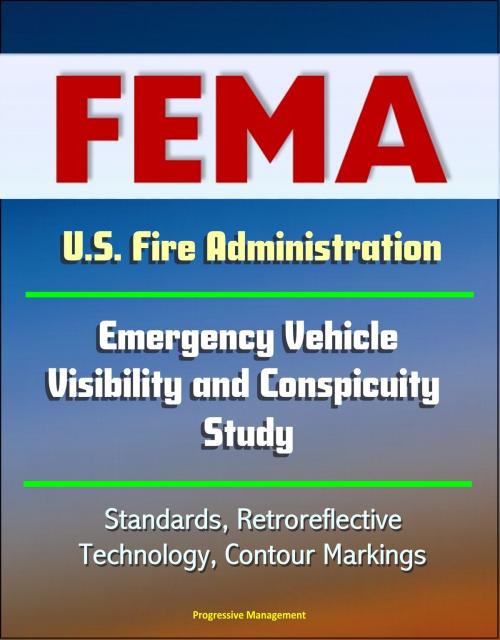FEMA U.S. Fire Administration Emergency Vehicle Visibility and Conspicuity Study: Standards, Retroreflective Technology, Contour Markings
Nonfiction, Social & Cultural Studies, Social Science| Author: | Progressive Management | ISBN: | 9781310382703 |
| Publisher: | Progressive Management | Publication: | September 5, 2014 |
| Imprint: | Smashwords Edition | Language: | English |
| Author: | Progressive Management |
| ISBN: | 9781310382703 |
| Publisher: | Progressive Management |
| Publication: | September 5, 2014 |
| Imprint: | Smashwords Edition |
| Language: | English |
This report, produced in partnership between the U.S. Fire Administration (USFA) and the International Fire Service Training Association (IFSTA), with support from the U.S. Department of Justice (DOJ), National Institute of Justice (NIJ), analyzes emergency vehicle visibility and conspicuity with an eye toward expanding efforts in these areas to improve vehicle and roadway operations safety for all emergency responders. Emphasis in this report is placed on passive visibility/conspicuity treatments; additional studies are underway on active technologies such as emergency vehicle warning lighting systems.
Over the past decade, numerous law enforcement officers, firefighters, and emergency medical services (EMS) workers were injured or killed along roadways throughout the United States. In 2008, as with the prior 10 years, more law enforcement officers died in traffic-related incidents than from any other cause; National Law Enforcement Officers Memorial over the past 12 years, an average of one officer per month was struck and killed by a vehicle in the United States. Preliminary firefighter fatality statistics for 2008 reflect 29 of 114 firefighters killed on duty perished in motor vehicle crashes, similar to figures posted in previous years. According to a 2002 study that aggregated data from several independent sources, at least 67 EMS providers were killed in ground transportation-related events over the 6 years from 1992 to 1997.
These sobering facts clearly demonstrate the importance of addressing vehicle characteristics and human factors for reducing the morbidity and mortality of public safety personnel operating along the Nation's highways and byways. Studies conducted in the United States and elsewhere suggest that increasing emergency vehicle visibility and conspicuity holds promise for enhancing first responders' safety when exposed to traffic both inside and outside their response vehicles (e.g., patrol cars, motorcycles, fire apparatus, and ambulances).
Preface * Executive Summary * Key Findings and Opportunities * Introduction * Methodology * Literature Review * Site Visits * Expert Panel * Background * Visibility * Conspicuity * Recognition/Identification * Action * Science Overview * Retroreflectivity Explained * Retroreflective Technology * International Best Practices * U.S. Emergency Vehicle Standards * NFPA 1901, Standard for Automotive Fire Apparatus * Federal Specification for the Star-of-Life Ambulance * Findings * Key Findings * Opportunities * Contour Markings * Conclusion * Photo Credits * References * Appendix A * FHWA Reflective Sheeting Identification Guide (FHWA, 2005)
This report, produced in partnership between the U.S. Fire Administration (USFA) and the International Fire Service Training Association (IFSTA), with support from the U.S. Department of Justice (DOJ), National Institute of Justice (NIJ), analyzes emergency vehicle visibility and conspicuity with an eye toward expanding efforts in these areas to improve vehicle and roadway operations safety for all emergency responders. Emphasis in this report is placed on passive visibility/conspicuity treatments; additional studies are underway on active technologies such as emergency vehicle warning lighting systems.
Over the past decade, numerous law enforcement officers, firefighters, and emergency medical services (EMS) workers were injured or killed along roadways throughout the United States. In 2008, as with the prior 10 years, more law enforcement officers died in traffic-related incidents than from any other cause; National Law Enforcement Officers Memorial over the past 12 years, an average of one officer per month was struck and killed by a vehicle in the United States. Preliminary firefighter fatality statistics for 2008 reflect 29 of 114 firefighters killed on duty perished in motor vehicle crashes, similar to figures posted in previous years. According to a 2002 study that aggregated data from several independent sources, at least 67 EMS providers were killed in ground transportation-related events over the 6 years from 1992 to 1997.
These sobering facts clearly demonstrate the importance of addressing vehicle characteristics and human factors for reducing the morbidity and mortality of public safety personnel operating along the Nation's highways and byways. Studies conducted in the United States and elsewhere suggest that increasing emergency vehicle visibility and conspicuity holds promise for enhancing first responders' safety when exposed to traffic both inside and outside their response vehicles (e.g., patrol cars, motorcycles, fire apparatus, and ambulances).
Preface * Executive Summary * Key Findings and Opportunities * Introduction * Methodology * Literature Review * Site Visits * Expert Panel * Background * Visibility * Conspicuity * Recognition/Identification * Action * Science Overview * Retroreflectivity Explained * Retroreflective Technology * International Best Practices * U.S. Emergency Vehicle Standards * NFPA 1901, Standard for Automotive Fire Apparatus * Federal Specification for the Star-of-Life Ambulance * Findings * Key Findings * Opportunities * Contour Markings * Conclusion * Photo Credits * References * Appendix A * FHWA Reflective Sheeting Identification Guide (FHWA, 2005)















